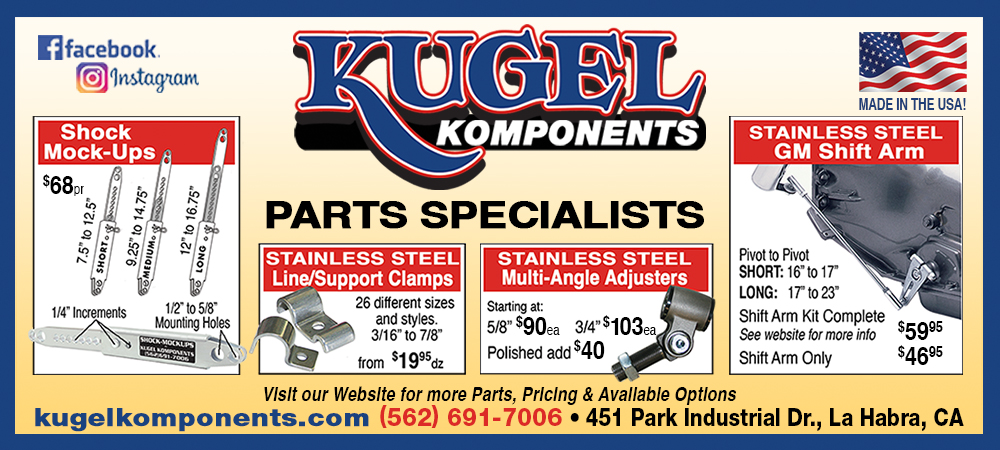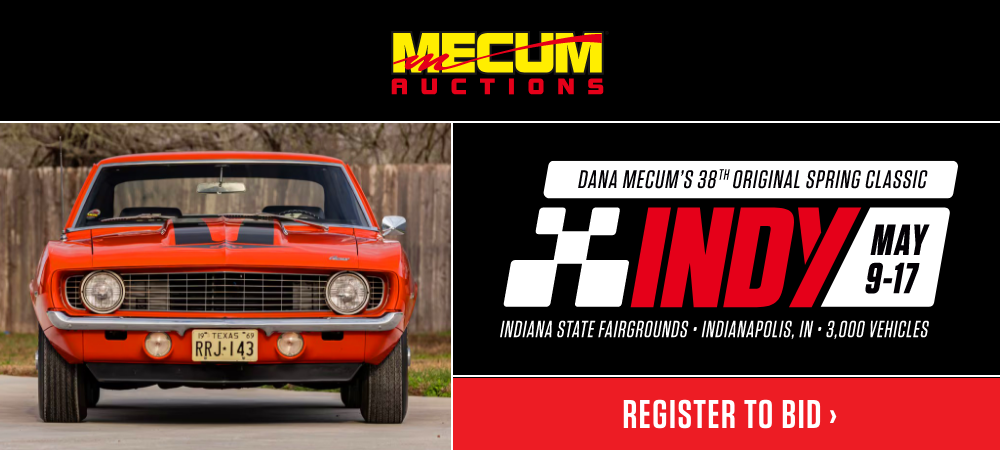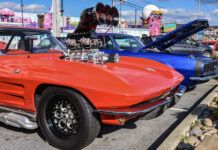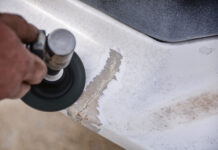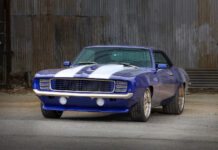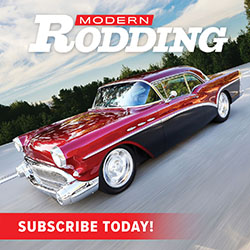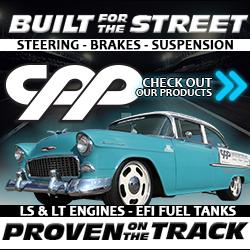By Nick Licata – Images by NotStock Photography
When people in the classic car hobby talk about Nomads, most folks associate that nameplate with Tri-Five Chevys (1955-57). Yes, the distinct two-door sport wagon was discontinued after the ’57 model year due to lackluster sales, but Chevrolet held onto the Nomad moniker for all ’58 Bel Air four-door station wagons denoting the flagship Chevrolet series. In 1959 the Nomad became the counterpart of the Impala, as in the wagon version, which carried on through the ’60 model.
In 1961 Chevrolet once again did a remodel of its fullsize B-body cars, including the station wagons, which at that point gave the Nomad a more conservative appearance but was still the top trim in Chevrolet’s world of wagons. By 1962 Chevrolet had retired the Nomad nameplate as the model was repackaged as the Impala station wagon.

After a six-year hiatus, Chevrolet revived the Nomad for the ’68 station wagons, replacing the Chevelle 300 station wagon. In 1969 Chevrolet split station wagons into a distinct model with the Nomad dropping the “Chevelle” name altogether. By 1972 the Nomad station wagon was deleted from the Chevelle line. Chevrolet continued to use the Nomad name through various other models, essentially watering it down to non-existence.

Don’t Miss Out: ART CROFT’S 1967 CHEVELLE MALIBU MUSCLE CAR
Wayne Robinson is an early Nomad fan and was on the hunt for a Tri-Five version to have built for his wife, Lynn, so he commissioned Dutchboys Hotrods in Vicksburg, Michigan, to take on the project. A few years prior Dutchboys built Wayne an outstanding ’69 Camaro, so he was confident they were the right shop to build the Nomad.

Being that Tri-Five Nomads are a rare find these days, Dutchboys had trouble locating a ’50s-era example in workable condition, but they did come across a ’69 for sale in nearby Kalamazoo. “I liked the idea of doing a ’69 Nomad due to them being somewhat less known than the ’50s variations, and I’ve always liked ’69 Chevelles so I bought the car and let the Dutchboys crew loose on the build,” Wayne says. “I know their style and build quality of cars that come out of their shop, so with a few minor guidelines on what I wanted on the car, I pretty much gave them creative freedom. The most difficult part of the whole process was keeping it a secret from Lynn, as I wanted it to be a surprise.”

Keeping the Nomad on the down-low, Wayne and the Dutchboys collaborated on a plan then moved forward on the 2½-year gestation. First and foremost was arming the car with a modern drivetrain and suspension components–a staple of a typical Dutchboys’ build.

Under the hood went late-model power by way of an LSA from Chevrolet Performance. The supercharged engine is a proven performer that boasts plenty of power and outstanding reliability. Knowing Lynn would spend a good amount of time behind the wheel, there would be no room for untimely roadside shenanigans, making this engine an excellent choice.

Beyond the Cam Motion supercharger cam, upgraded valvetrain, and underdrive Griptec pully, the engine was basically left in stock configuration. The Dutchboys dressed up the LSA supercharger lid with a powdercoat texture and incorporated an LS Classics chrome valve covers to evoke a small-block aesthetic that complements the car’s late-’60s ambience. For additional Dutchboys style, they created a custom closeout panel and smoothed the firewall.

More Chevelle Love: Pro Touring 1970 Chevy Chevelle
The LSA breathes in via a specially designed, hand-fabricated, aluminum, cold-air intake system and releases greenhouse through a set of Holley 1 7/8-inch headers connected to a custom 3-inch stainless exhaust topped with a pair of Holley Blackheart mufflers. The combination ensures superb airflow, while giving the former grocery getter discreet rumble at idle, which transforms into a thunderous roar when Lynn unleashes the LSA’s formidable 649 hp—more than enough grunt to effortlessly scoot this heavy Chevy down the road.

To handle the extra power, Bowler Transmissions beefed up the 4L80 transmission that sends torque to a 9-inch rearend stuffed with an Eaton Truetrac posi unit and 3.55 road-friendly gears—a perfect setup for taking this long car on long trips.
To ensure a comfortable, performance-oriented driving experience the stock chassis was enhanced with a Detroit Speed Speed Kit 3. At the rear, improvements include Detroit Speed’s Swivel-Links, JRi coilover shocks paired with 300-pound springs, and the addition of a rear sway bar. Up front, the setup boasts Detroit Speed tubular control arms and spindles, resulting in an aggressive stance combined with more precise cornering. Completing the setup, Detroit Speed 550-pound springs surround JRi coilover shocks and a 1 1/8-inch sway bar ensures the beefy wagon maintains stability and a level ride.

Forgeline OE1 wheels wrapped in Diamond Back redline rubber aim to project a sleeper appearance, but a closer inspection reveals the wider 275 rubber front and rear tells the story of a wagon capable of doing unwagon-like things. To coincide with the Nomad’s improved handling ability, effective braking comes by way of Corvette C6 binders on all corners commanded by a Detroit Speed master cylinder and booster supported by a Baer proportioning valve.

Within the driver area, a stock-like ambience is maintained, enhanced with black leather adorning the factory bench seat and door panels. Black loop carpet is laid throughout the extensive floor space. An ingeniously crafted side pocket provides a convenient space for tools, supplies, and, in this case, a Yeti cooler loaded with cool beverages and snacks. The massive real estate offers ample space for luggage or other roadworthy essentials. Up front, the factory dash was treated to Dakota Digital gauges for updated engine monitoring. Additionally, a Classic Car audio head unit occupies the shared space with the Vintage Air control panel, seamlessly blending in with the overall vintage vibe.

“We had to reconstruct the massive passenger side quarter-panel due to the unavailability of replacements for this wagon,” Dutchboys’ Jason Mitchell explains. “That meant removing and repairing the existing piece, fill the rusted areas, reinstall, then sharpen all the edges.”

With yards of uninterrupted sheetmetal, every imperfection becomes magnified, demanding meticulous attention to detail, further lengthening the already labor-intensive bodywork preparation process. Nevertheless, the Dutchboys were up to the challenge and created a stellar canvas prior to applying a rich coat of BASF Tahoe Turquoise paint. The result is a flawless finish that showcases their superb bodywork and painting prowess. Adding to the allure, Advanced Plating revitalized the half-century-old trim pieces that brilliantly complement the exterior of this rare wagon.

Following the completion of the build, Wayne and Lynn picked up the car from the Dutchboys headquarters and headed out on a six-hour drive to St. Ignace, situated on Michigan’s upper peninsula. Enjoying the ride so much, they opted for a scenic route back home, turning the six-hour trip into a nine-hour adventure. “I must admit,” Wayne exclaims. “The car performed flawlessly throughout the entire drive. It has more than enough power and exceptional handling, exceeding all expectations. The best part is that Lynn absolutely loves the car. We are really looking forward to putting thousands of miles on the car, and with the additional space the wagon offers, we can load it up, hit the road, and be gone for as long as we choose.”

TECH CHECK
Owner: Lynn & Wayne Robinson, Hockessin, Deleware
Vehicle: ’69 Chevelle Nomad Wagon
Engine
Type: Chevrolet Performance LSA
Displacement: 376 ci
Compression Ratio: 9.1:1
Bore: 4.065 inches
Stroke: 3.622 inches
Cylinder Heads: Aluminum L92-style port
Rotating Assembly: Forged crankshaft, powdered metal rods, hypereutectic aluminum pistons
Valvetrain: BTR 0.660 springs, stock rockers, Cam Motion 5/14 0.080 pushrods
Camshaft: Cam Motion PD Supercharger Cam, 0.595/586 lift, 224/238 duration at 0.050, 118 LSA
Induction: 1.9L Eaton TVS supercharger
Valve Covers: LS Classic small-block Chevy
Fuel Injection: Holley EFI Terminator X
Assembly: Chevrolet Performance
Exhaust: Holley headers, Dutchboys 3-inch custom exhaust, Holley Blackheart mufflers
Ancillaries: SPAL fan, C&R aluminum radiator, 2.55-inch ZPE Griptec pulley
Output: 649 hp at 6,250 rpm, 632 lb-ft torque at 5,850 rpm
Drivetrain
Transmission: GM 4L80-E by Bowler Performance Transmissions
Driveshaft: Inland Empire Driveline
Rear Axle: Ford 9-inch, limited-slip posi, 3.55:1 gears, 31-spline Moser axles
Chassis
Chassis: Stock
Front Suspension: Detroit Speed spindles, tubular control arms, and 550-pound springs; JRi coilover shocks; 1 1/8-inch Detroit Speed sway bar; Turn One steering box
Rear Suspension: Detroit Speed Swivel-Links, 300-pound springs, JRi coilover shocks
Brakes: C6 Corvette 12.8-inch rotors, four-piston calipers front, C6 Corvette 12-inch rotors, two-piston calipers rear, Detroit Speed master cylinder, Baer proportioning valve
Wheels & Tires
Wheels: Forgeline OE1 19×9.5 front, 20×10 rear
Tires: Diamond Back EVO 275/30R19 front, 275/30R20 rear
Interior
Upholstery: Stock
Installation: Dutchboys
Seats: Stock bench, black leather
Carpet: Black loop
Steering: Ididit steering column, GM Comfort Grip steering wheel
Shifter: Column
Dash: Stock
Instrumentation: Dakota Digital
Pedals: Stock
HVAC: Vintage Air
Insulation: DEI
Stereo Head Unit: Classic Car Audio
Speakers: Kicker (4)
Wiring: American Autowire
Exterior
Bodywork and Paint: Dutchboys
Paint: BASF Tahoe Turquoise
Grille: Stock
Front Bumper: Stock
Rear Bumper: Stock
Hood: SS
Headlights: Holley Bright Drive
Taillights: Stock with LED
Outside Mirrors: ’70 Olds Cutlass
Plating: Advanced Plating
Click on this issue’s cover to see the enhanced digital version of 1969 Chevelle Nomad Wagon Restomod.












